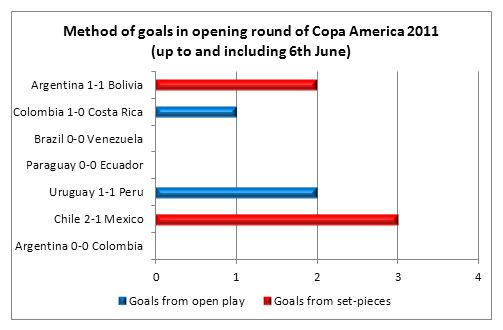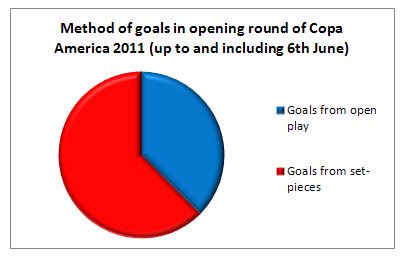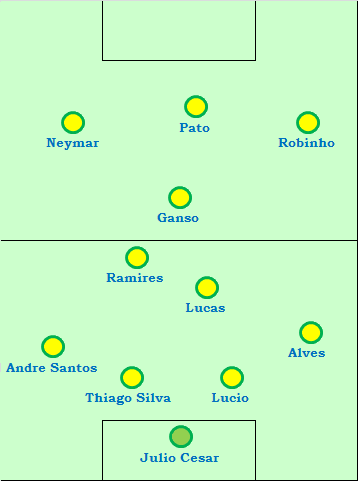
The starting line-ups
 The starting line-ups
Bolivia took the lead at the start of the second half, but Sergio Aguero’s thumping volley rescued a draw for the hosts in the opening Copa America game.
Sergio Batista’s main decision was whether to start Carlos Tevez or Angel di Maria on the left of his front three. He went for Tevez. Marco Rojo got the nod at left-back, and Sergio Romero started in goal.
Gustavo Quinteros chose a 4-4-2 / 4-4-1-1 system, with Edivaldo Rojas just off Marcelo Moreno Martins upfront.
The stars here were Bolivia, of course, but all the tactical interest came from Argentina’s two systems.
Quinteros’ formation was extremely effective but also very simple – a defensive-minded shape with two narrow banks of four, trying to make it difficult for Argentina to play through them.
Argentina wide forwards
Just as in South Africa last summer, Tevez has forced his way into the side despite seemingly being out of the coach’s intended first XI shortly before the tournament started. He was asked to play as a left-sided forward here.
There was an interesting contrast, then, between the positioning and movement of Tevez and Ezequiel Lavezzi. Lavezzi is used to playing as a wide forward for Napoli all season (albeit usually on the opposite flank), and his positioning -starting outside the full-back, before making diagonal runs towards goal – suited Messi well. The number ten could dribble with the ball and then slip it between centre-back and full-back to Lavezzi, as he did most famously in the 5-0 Clasico. This produced a good chance on 25 minutes, but Lavezzi’s finish was wayward – and the Napoli man’s end product throughout the first half was poor, and didn’t take advantage of his good understanding of the system.
Tevez generally played narrower and was less effective at trying to stretch the Bolivia defence, which wanted to be narrow. They were also happy to play reasonably high up the pitch, however. Although one defender often came out to meet Messi, the full-backs tucked in to prevent the centre of the pitch opening up. They also had the pacey Ronaldo Rivero to cover, and besides, there was often no Argentina player looking to exploit the space anyway.
That problem was related to the role of Banega, who did a decent job with the ball at his feet connecting midfield and attack, but was cautious with his movement off the ball. When Messi plays in the centre and drops deep he attracts two or three players to him, opening up space for an attacking midfielder to exploit – at club level, most frequently Andres Iniesta. Banega remained quite deep, however, and there was no real need for him to do so with both Javier Mascherano and Esteban Cambiasso in that zone, plus no real driving runs from midfield from Bolivia.
Another difference between Argentina and Barcelona, in relation to Messi (it must be said that comparing Batista’s side to the greatest club side in the world and arguably one of the best of all time is extremely harsh, but since replicating those conditions for Messi has been one of his main goals, the comparison must be made) is the fact that Argentina don’t press anything like as much as Barca, and the wide players instead drop back when they lose possession. That leaves Messi as the highest player up the pitch in a 4-1-4-1ish shape, which prevents quick combinations between he and the two wide forwards on the break.
Second half
The starting line-ups
Bolivia took the lead at the start of the second half, but Sergio Aguero’s thumping volley rescued a draw for the hosts in the opening Copa America game.
Sergio Batista’s main decision was whether to start Carlos Tevez or Angel di Maria on the left of his front three. He went for Tevez. Marco Rojo got the nod at left-back, and Sergio Romero started in goal.
Gustavo Quinteros chose a 4-4-2 / 4-4-1-1 system, with Edivaldo Rojas just off Marcelo Moreno Martins upfront.
The stars here were Bolivia, of course, but all the tactical interest came from Argentina’s two systems.
Quinteros’ formation was extremely effective but also very simple – a defensive-minded shape with two narrow banks of four, trying to make it difficult for Argentina to play through them.
Argentina wide forwards
Just as in South Africa last summer, Tevez has forced his way into the side despite seemingly being out of the coach’s intended first XI shortly before the tournament started. He was asked to play as a left-sided forward here.
There was an interesting contrast, then, between the positioning and movement of Tevez and Ezequiel Lavezzi. Lavezzi is used to playing as a wide forward for Napoli all season (albeit usually on the opposite flank), and his positioning -starting outside the full-back, before making diagonal runs towards goal – suited Messi well. The number ten could dribble with the ball and then slip it between centre-back and full-back to Lavezzi, as he did most famously in the 5-0 Clasico. This produced a good chance on 25 minutes, but Lavezzi’s finish was wayward – and the Napoli man’s end product throughout the first half was poor, and didn’t take advantage of his good understanding of the system.
Tevez generally played narrower and was less effective at trying to stretch the Bolivia defence, which wanted to be narrow. They were also happy to play reasonably high up the pitch, however. Although one defender often came out to meet Messi, the full-backs tucked in to prevent the centre of the pitch opening up. They also had the pacey Ronaldo Rivero to cover, and besides, there was often no Argentina player looking to exploit the space anyway.
That problem was related to the role of Banega, who did a decent job with the ball at his feet connecting midfield and attack, but was cautious with his movement off the ball. When Messi plays in the centre and drops deep he attracts two or three players to him, opening up space for an attacking midfielder to exploit – at club level, most frequently Andres Iniesta. Banega remained quite deep, however, and there was no real need for him to do so with both Javier Mascherano and Esteban Cambiasso in that zone, plus no real driving runs from midfield from Bolivia.
Another difference between Argentina and Barcelona, in relation to Messi (it must be said that comparing Batista’s side to the greatest club side in the world and arguably one of the best of all time is extremely harsh, but since replicating those conditions for Messi has been one of his main goals, the comparison must be made) is the fact that Argentina don’t press anything like as much as Barca, and the wide players instead drop back when they lose possession. That leaves Messi as the highest player up the pitch in a 4-1-4-1ish shape, which prevents quick combinations between he and the two wide forwards on the break.
Second half
 Batista switched to 4-2-1-3 for the second half
All of this meant that Batista immediately turned to his plan B at half time, a 4-2-1-3. Cambiasso was removed, with Angel di Maria on as a left-winger, and Tevez becoming a centre-forward. Messi moved deeper, behind the three forwards.
The issue is then about Messi’s positioning – he appeared too deep, generally picking the ball up deeper than the two Bolivia holding players, forced away from goal by Tevez’s presence. Just as Tevez rather got in Messi’s way and forced him too deep against Argentina last year as a second striker, he was broadly doing the same thing as the main central striker here. What kind of player would Messi want to play behind in this system? Tevez, a false nine at club level, is probably not the best option.
Amongst all this, something far more important happened – Bolivia scored from their first real attempt of the game, as Rojas flicked in a corner kick at the near post, and Banega miscued the ball over the line. Bolivia could then sit deeper, with Rojas dropping off as more of a fifth midfielder and pressuring Argentina’s two holders.
Argentina pushed up, which exposed the lack of pace of their centre-backs, something that will surely be exploited at some point in this tournament. Here, we had a brief glimpse of it – Moreno had all the time he liked with a one-on-one against Romero, but wasted the chance.
Batista had already reached for his alternative shape, and so had to stay with that same system. Sergio Aguero came on for Lavezzi and had an instant impact – superbly volleying home after Nicolas Burdisso had gone forward for a free-kick. That raised another question – whether Argentina needed a proper number nine who could, like Burdisso, be an aerial threat in the box.
Argentina rallied late on, but Bolivia defended well and were content to do the basics as Argentina struggled to work out their best system.
Conclusion
The tactical decision-making and the actual game were almost two different things here. Both goals came from set-plays – and from (a) a mistake on the line and (b) a brilliant finish, rather than any great example of combination play.
The match further outlined how many attacking options Batista has – Diego Milito, Gonzalo Higuain and Javier Pastore weren’t used at all – but provides more questions than answers. Tevez and Messi in the same team appears to be a problem unless their relationship improves significantly, and it would be a surprise if Batista starts against Colombia with the same team that played here.
Batista switched to 4-2-1-3 for the second half
All of this meant that Batista immediately turned to his plan B at half time, a 4-2-1-3. Cambiasso was removed, with Angel di Maria on as a left-winger, and Tevez becoming a centre-forward. Messi moved deeper, behind the three forwards.
The issue is then about Messi’s positioning – he appeared too deep, generally picking the ball up deeper than the two Bolivia holding players, forced away from goal by Tevez’s presence. Just as Tevez rather got in Messi’s way and forced him too deep against Argentina last year as a second striker, he was broadly doing the same thing as the main central striker here. What kind of player would Messi want to play behind in this system? Tevez, a false nine at club level, is probably not the best option.
Amongst all this, something far more important happened – Bolivia scored from their first real attempt of the game, as Rojas flicked in a corner kick at the near post, and Banega miscued the ball over the line. Bolivia could then sit deeper, with Rojas dropping off as more of a fifth midfielder and pressuring Argentina’s two holders.
Argentina pushed up, which exposed the lack of pace of their centre-backs, something that will surely be exploited at some point in this tournament. Here, we had a brief glimpse of it – Moreno had all the time he liked with a one-on-one against Romero, but wasted the chance.
Batista had already reached for his alternative shape, and so had to stay with that same system. Sergio Aguero came on for Lavezzi and had an instant impact – superbly volleying home after Nicolas Burdisso had gone forward for a free-kick. That raised another question – whether Argentina needed a proper number nine who could, like Burdisso, be an aerial threat in the box.
Argentina rallied late on, but Bolivia defended well and were content to do the basics as Argentina struggled to work out their best system.
Conclusion
The tactical decision-making and the actual game were almost two different things here. Both goals came from set-plays – and from (a) a mistake on the line and (b) a brilliant finish, rather than any great example of combination play.
The match further outlined how many attacking options Batista has – Diego Milito, Gonzalo Higuain and Javier Pastore weren’t used at all – but provides more questions than answers. Tevez and Messi in the same team appears to be a problem unless their relationship improves significantly, and it would be a surprise if Batista starts against Colombia with the same team that played here.

Argentina pushed up, which exposed the lack of pace of their centre-backs, something that will surely be exploited at some point in this tournament.
这句话太可怕了!
CFT 发表于 2011-7-3 12:20




Tevez and Messi in the same team appears to be a problem unless their relationship improves significantly, and it would be a surprise if Batista starts against Colombia with the same team that played here.




 Posted by Jonathan Wilson in La Plata Monday 4 July 2011 10.10 BST guardian.co.uk
Posted by Jonathan Wilson in La Plata Monday 4 July 2011 10.10 BST guardian.co.uk









 Posted by Jonathan Wilson in Santa Fe Thursday 7 July 2011 14.57 BST guardian.co.uk
Posted by Jonathan Wilson in Santa Fe Thursday 7 July 2011 14.57 BST guardian.co.uk



乌拉圭是不断在三、四后卫中进行切换
智利的三后卫就相对明显一点
实际上智利队在防守阵型中也经常变成四后卫,后腰梅德尔的位置会回收到庞塞的身边,作为一名上抢的中卫 ...
北极海 发表于 2011-7-10 10:57


34楼的翻译,明显有个人喜好在里面的。例如,正文的第一二段的翻译中一些词的使用上,不是很恰当的。
看俺的翻译,味道肯定不一样。
例如“庸才”一词,这是个定性说法,最好不要轻易使用。而原文只不过是ordinary ...
elite 发表于 2011-7-9 15:12






















56# Penelope
“Messi picking the ball up, running with it, and slipping the ball through to a left-sided attacker to finish – first Aguero, then Di Maria. The runs from the latter two are exactly ...
ychee 发表于 2011-7-13 19:19

 The starting line-ups
The starting line-ups巴西人一直在打4213
打巴拉圭的小组赛稍有变化,介于4213、4222和4231之间
主要是由于内马尔和雅德松(后换为埃拉诺)的位置比较活
但根本上,巴西队是双后腰+单前腰+三前锋框架 ...
北极海 发表于 2011-7-15 11:22
巴西4-2胜厄瓜多尔的比赛没看,但是麦孔比阿尔维斯表现好是可以预料的
巴西做不到像巴萨那样场均70%的控球率,并把后防线推到离底线40-45米的距离
这样阿尔维斯防守力的缺陷就容易被对手所利用了 ...
北极海 发表于 2011-7-15 11:25
巴西这支球队,如果你给他们足够空间的话,威胁非常大,巴西球员与生俱来的技术和速度自不消说,他们投入进攻的兵力也非常多,有时只留卢卡斯,席尔瓦和卢西奥这仨在后场,这也是利用人数优势弥补攻击手年轻,决定性 ...
午时靡深蓝 发表于 2011-7-15 11:31
73# Alex2011
厄瓜多尔这个进两球的凯赛多是个牛逼人物,坚决果断。在今年的西甲也打进了十几个球,我记得还进了巴萨一球,戏耍了皮克(好像是皮克犯2了)
巴拉圭打巴西那场压迫的非常不错。巴拉圭的身体优势和在 ...
午时靡深蓝 发表于 2011-7-15 11:38

巴拉圭的后场就个人能力来说不会强于阿根廷
巴拉圭胜在整体防守贯彻的好,全队都注重就地反抢和压迫,换句话说他们是牺牲了部分进攻的力量来换取更高质量的防守,阿根廷不会采用这样的战术。 ...
午时靡深蓝 发表于 2011-7-15 11:54
如果上卡瓦尼的话就不能打442了
自从对智利队的下半场开始,塔瓦雷斯就弃433而用442
所以说卡瓦尼更可能出现在替补席作为后手而不是首发
用阿尔瓦罗-冈萨雷斯专门和迪-马里亚兑子应该说也是个不错的选择
因此我预 ...
北极海 发表于 2011-7-15 12:31
我预测一个乌拉圭周日的首发,不一定完全能猜对
Formation: 4411
GK: Muslera
RB: Maxi Pereira, CB: Lugano & Coates, LB: Caceres
RM: Alvaro Gonzalez, DM: Diego Perez & Arevalo, LM: Alvaro Pereira
SS: Forlan
CF: Suarez
北极海 发表于 2011-7-15 12:16


到了后来,野兽换下KUN,回撤打中场,梅西顶到锋线,实在是很无厘头的一招,野兽虽然在中场可以拿住球,但创造力有限,传不到前锋线上去,等于浪费了梅西的作用,这和老马在世界杯下半时对德国用的招完全一模一样。
...
苍生劫 发表于 2011-7-17 21:41
| 欢迎光临 阿根廷风暴 (http://112.124.10.157/) | Powered by Discuz! X3.2 |